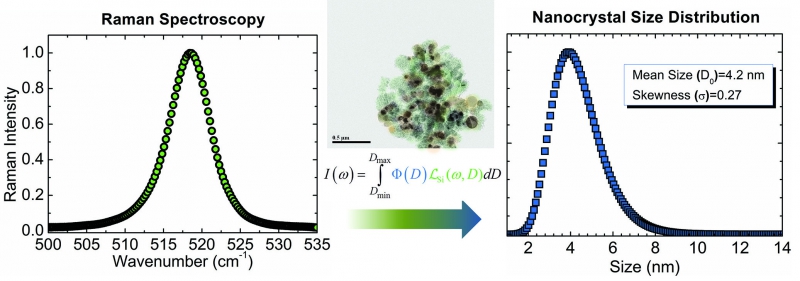26 October 2015
Physicist Ilker Dogan is looking hard at pieces of silicium that are literally too small to see. But ring them like a gong by scattering light off of them, and the physicist at DIFFER and TU/e can tell you quickly and without destroying the sample what sizes of nanoparticles you have grown in your experiment. These particles can be used from solar panels to lithium-ion batteries and catalysts, and their size greatly determines how efficiently they can process energy or matter. Dogan published his sizing technique in the Journal of Visualized Experiments.
Characterization of Nanocrystal Size Distribution using Raman Spectroscopy with a Multi-particle Phonon Confinement Model
İ. Doğan, M.C.M. van de Sanden, Journal of Visualized Experiments, doi: 10.3791/53026
See the accompanying movie
Existing techniques to size nanoparticles are either very slow - making it hard to quickly adapt production settings - or destroy their samples. Not so with Raman scattering, which only uses light to probe a material. Says Doğan: "The paper compares transmission electron microscopy (TEM), photoluminescence spectroscopy (PL), and x-ray diffraction (XRD). All these techniques require either extensive preparation or extensive measurement times. Moreover, TEM is usually a destructive technique. In Raman spectroscopy, a single measurement can be done in a few minutes, but in PL, TEM and XRD a complete characterization can take tens of minutes to hours."

Physicist Ilker Dogan is looking hard at pieces of silicium that are literally too small to see. But ring them like a gong by scattering light off of them, and the physicist at DIFFER and TU/e can tell you quickly and without destroying the sample what sizes of nanoparticles you have grown in your experiment. These particles can be used from solar panels to lithium-ion batteries and catalysts, and their size greatly determines how efficiently they can process energy or matter. Dogan published his sizing technique in the Journal of Visualized Experiments.
Characterization of Nanocrystal Size Distribution using Raman Spectroscopy with a Multi-particle Phonon Confinement Model
İ. Doğan, M.C.M. van de Sanden, Journal of Visualized Experiments, doi: 10.3791/53026
See the accompanying movie
 Ringing like a gong
Ringing like a gong
İlker Doğan demonstrated his sizing technique with silicium, but in principle, any nanoparticle showing semiconductor properties can be sized this way. The physicist presents his use of Raman scattering as a paper and video in the Journal of Visualized Experiments. "Raman scattering itself isn't a new technique - although it's hard, you're looking at very faint signals coming off of pieces of material a few nanometers (billionth of a meter) in size. What is new here is how we can pull both the average size and the variation of particle sizes from a single experiment using a simplified analytical model."
Existing techniques to size nanoparticles are either very slow - making it hard to quickly adapt production settings - or destroy their samples. Not so with Raman scattering, which only uses light to probe a material. Says Doğan: "The paper compares transmission electron microscopy (TEM), photoluminescence spectroscopy (PL), and x-ray diffraction (XRD). All these techniques require either extensive preparation or extensive measurement times. Moreover, TEM is usually a destructive technique. In Raman spectroscopy, a single measurement can be done in a few minutes, but in PL, TEM and XRD a complete characterization can take tens of minutes to hours."
Time saver for industry
"The trick was simplifying a complicated quantum mechanical model of how atoms in matter vibrate and comparing the data to this analytical model. This will even reveal when you have a group of small particles mixed in with large ones." The technique to quickly size up a batch of nanoparticles is potentially interesting for research and industry, thinks Doğan. Being able to swiftly determine if a production process delivers the right nanoparticles can save expensive and time-consuming analyses.
Next up: size and chemical activity in one glance
In follow-up research, the researcher wants to go a step beyond determining size. With the same technique, it should also be possible to tease chemical reactivity from the data. "In one quick measurement, we'll be able to measure what particles we've grown in an experiment and how their chemistries evolve."Go to the News page.